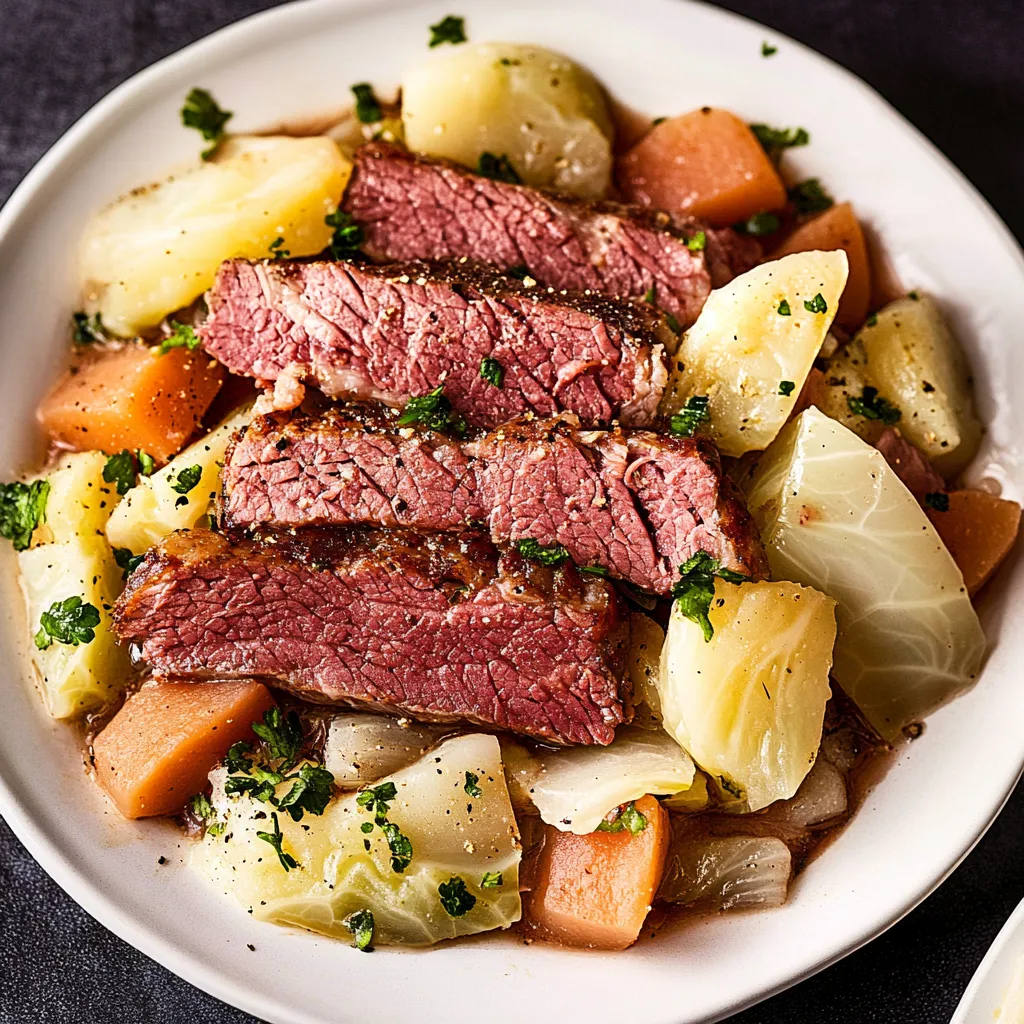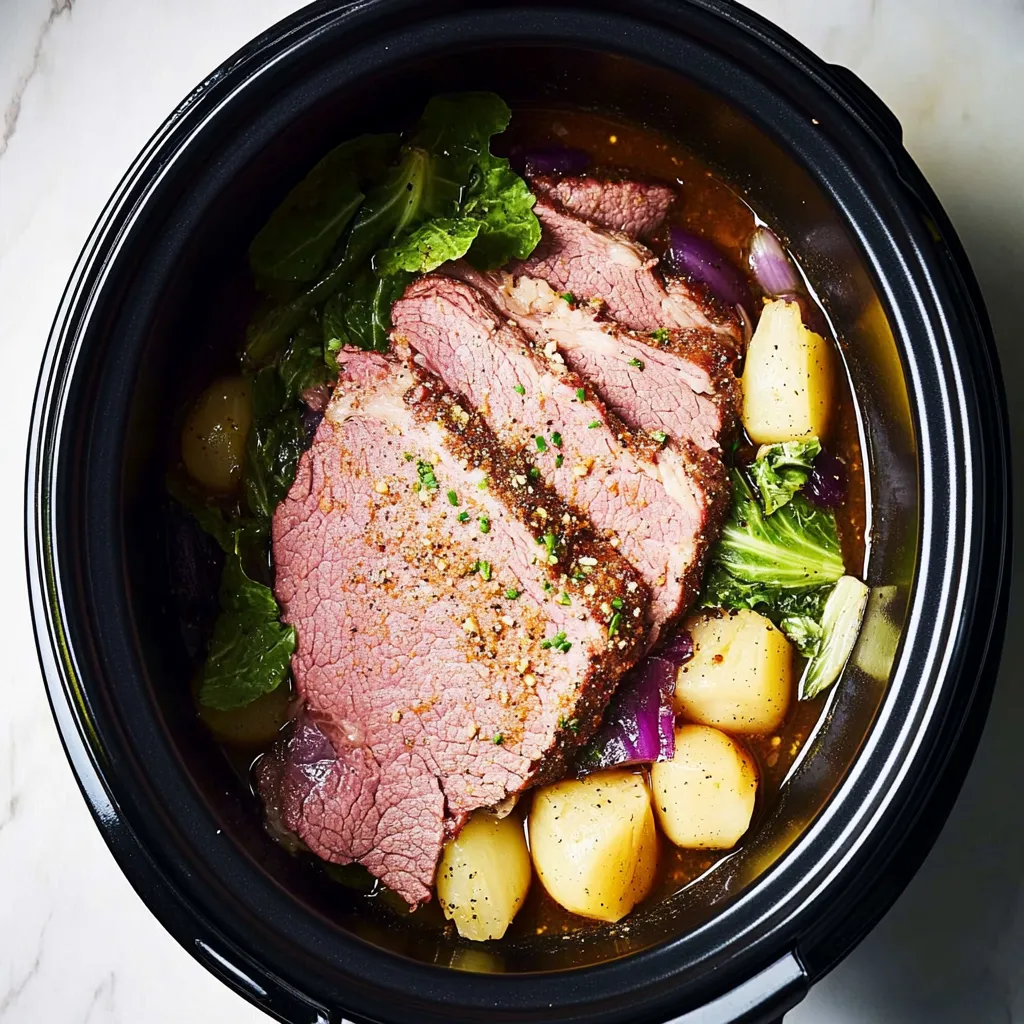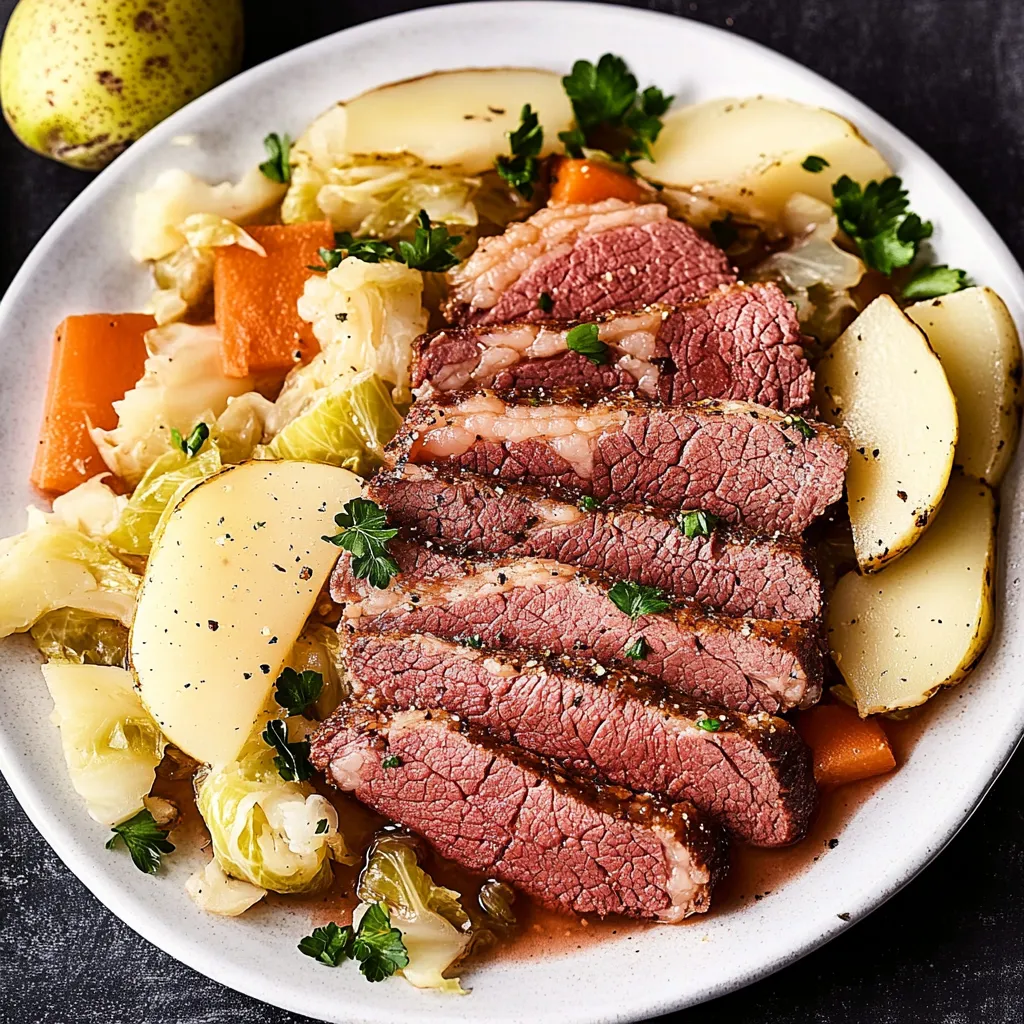 Pin it
Pin it
This slow cooker corned beef and cabbage recipe transforms a traditional Irish-American favorite into a hands-off meal that practically cooks itself. The long, gentle cooking creates fork-tender meat and vegetables infused with savory flavors that will warm your home with their inviting aroma.
I discovered this recipe when looking for ways to celebrate St. Patrick's Day without spending hours in the kitchen. Now it's become our family tradition not just in March but throughout the cooler months when we crave something hearty and comforting.
Ingredients
- Corned beef brisket: Gives this dish its distinctive flavor and serves as the hearty centerpiece
- Pickling spices: Enhance the traditional flavor profile and complement the brined meat
- Lager or brown ale: Adds depth and subtle maltiness to the cooking liquid
- Apple cider vinegar: Balances the richness with a touch of brightness
- Savoy cabbage: Holds its texture better than regular cabbage during slow cooking
- Waxy potatoes: Like Yukon golds maintain their shape rather than disintegrating
- Carrots: Add natural sweetness and vibrant color to the finished dish
- Fresh thyme: Brings an earthy aromatic element that ties all flavors together
Step-by-Step Instructions
- Preheat the Slow Cooker:
- Set your slow cooker to the LOW setting while you prepare the vegetables. This gives your appliance time to warm up and ensures even cooking from the start.
- Season and Position the Brisket:
- Place the brisket with fat side facing up in the slow cooker to allow the fat to render and baste the meat as it cooks. Sprinkle with pickling spices, sugar, and salt to create a flavorful crust.
- Create the Cooking Liquid:
- Pour in the beer and enough water to just cover the brisket, then add vinegar. This combination creates a flavorful broth that will infuse everything with rich taste while keeping the meat moist.
- Add Root Vegetables:
- Layer carrots, potatoes, onions, and thyme over the brisket. These heartier vegetables can withstand the longer cooking time and will absorb the savory flavors of the meat and broth.
- Low and Slow Cooking:
- Cover and let cook until the brisket and vegetables reach perfect tenderness, which takes 8 to 10 hours on LOW or 4 to 5 hours on HIGH. This slow process allows the meat fibers to break down properly.
- Add Cabbage at the End:
- Place cabbage wedges on top for the final 45 minutes. Adding cabbage later prevents it from overcooking and turning mushy while still allowing it to absorb the delicious flavors.
- Slice and Serve:
- Remove the brisket and slice thinly across the grain for the most tender texture. Use a slotted spoon to serve the vegetables alongside the meat, creating a complete one-pot meal.
 Pin it
Pin it
The pickling spices are truly the secret weapon in this recipe. I once tried making it without them, thinking the corned beef already had enough flavor, and the difference was remarkable. Those little seeds and berries might not look like much, but they infuse everything with a complex taste that makes this dish special.
Choosing the Right Cut
When shopping for corned beef, you might encounter flat cut or point cut options. The flat cut is leaner and slices beautifully, making it perfect for presentation. The point cut has more marbling and fat, resulting in a more tender and flavorful result but slightly messier slicing. Either works wonderfully in this slow cooker recipe, though I personally prefer the point cut for its juiciness.
Timing Flexibility
One of the greatest advantages of this slow cooker method is its forgiveness with timing. While the recipe specifies 8 to 10 hours on LOW, the dish can actually hold well for up to 12 hours total cooking time. This makes it perfect for workdays when you might be delayed getting home. The only adjustment needed is to perhaps wait until closer to return time to add the cabbage for its 45 minute finish.
Serving Suggestions
While this dish is certainly complete on its own, I love serving it with a side of whole grain mustard and fresh Irish soda bread for sopping up the flavorful broth. For a more modern twist, try serving the sliced corned beef on toasted rye bread with Swiss cheese and sauerkraut for an incredible Reuben sandwich the next day. The cooking liquid also makes an excellent base for a hearty vegetable soup later in the week.
 Pin it
Pin it
This recipe is the perfect blend of tradition and convenience, ensuring a hearty, flavorful meal with minimal effort.
Frequently Asked Questions
- → Can I use flat-cut or point-cut brisket for this dish?
Either flat-cut or point-cut brisket works well. Flat-cut (also called first-cut) is leaner and slices more neatly, while point-cut has more marbling and can be more flavorful and tender. Choose based on your preference for leanness versus richness.
- → What can I substitute for the beer in this dish?
If you prefer not to use beer, substitute with beef broth or stock for savory depth. Apple juice mixed with a tablespoon of vinegar can also work well, providing both sweetness and acidity that complements the corned beef.
- → Why is my corned beef tough after slow cooking?
Tough corned beef usually means it hasn't cooked long enough. This cut needs extended low-temperature cooking to break down connective tissues. Ensure you're cooking on LOW for the full 8-10 hours, or until the meat is fork-tender. Also, always slice against the grain when serving.
- → Can I cook this on HIGH to save time?
Yes, you can cook on HIGH for 4-5 hours instead of LOW for 8-10 hours. However, cooking on LOW generally produces more tender meat as it allows the connective tissues to break down more slowly and thoroughly. If using HIGH, check for tenderness before serving.
- → What type of cabbage works best with corned beef?
Savoy cabbage is specified in this dish for its tender leaves and mild flavor, but regular green cabbage works perfectly well too. Red cabbage can be used but will change the color of the cooking liquid and other vegetables. For the best texture, add any cabbage variety during only the last 45 minutes of cooking.
- → How do I store and reheat leftovers?
Store leftovers in an airtight container in the refrigerator for up to 4 days. Reheat gently in a covered saucepan with some of the cooking liquid over medium-low heat, or in a microwave at 50% power to prevent the meat from toughening. The flavors often improve after a day in the refrigerator.
